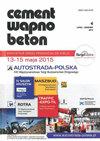Analysis of the environmental impact of the production of building gypsum using natural and flue gas desulfurization gypsum in the Polish context
IF 0.6
4区 工程技术
Q4 CONSTRUCTION & BUILDING TECHNOLOGY
引用次数: 1
Abstract
The production of construction products is associated with energy and raw materials consumption, including those of natural origin. Their use is associated with the generation of significant quantity of waste and the emission of greenhouse gases. Therefore, for the sustainable development of civilization, it is essential to reduce the environmental impact of construction products. Gypsum is one of the primary mineral binders, commonly used in construction. The study compares the effect on the environment of building gypsum made of natural raw materials and gypsum obtained in the flue gas desulfurization process. Nine environmental impact indicators were analyzed: global warming potential – GWP, stratospheric ozone layer depletion potential – ODP, soil and water acidification potential – AP, eutrophication potential – EP, tropospheric ozone formation potential – POCP, abiotic depletion potential for non-fossil resources – ADP-elements and fossil resources-ADP-fossil fuels, total use of renewable primary energy resources – PERT and total use of non-renewable primary energy resources – PENRT. Higher values of all considered indicators were obtained for building gypsum made of raw material from flue gas desulfurization processes. The environmental impact assessment was carried out using the Life Cycle Assessment [LCA] method and actual production data from 2017. The life cycle analyzed in this paper covered modules from A1 to A3, i.e., from the extraction/acquisition of raw materials to the finished product, delivered to the factory gate.分析了波兰使用天然石膏和烟气脱硫石膏生产建筑石膏对环境的影响
建筑产品的生产与能源和原材料消耗有关,包括天然来源的能源和原材料。它们的使用与产生大量废物和排放温室气体有关。因此,为了文明的可持续发展,减少建筑产品对环境的影响至关重要。石膏是一种主要的矿物粘结剂,常用于建筑中。比较了天然原料生产的建筑石膏与烟气脱硫工艺生产的石膏对环境的影响。分析了9个环境影响指标:全球变暖潜势- GWP、平流层臭氧层消耗潜势- ODP、土壤和水酸化潜势- AP、富营养化潜势- EP、对流层臭氧形成潜势- POCP、非化石资源的非生物消耗潜势- adp元素和化石资源- adp化石燃料、可再生一次能源利用总量- PERT和不可再生一次能源利用总量- PENRT。以烟气脱硫工艺为原料生产的建筑石膏各项指标均较高。采用生命周期评价(LCA)方法和2017年的实际生产数据进行环境影响评价。本文分析的生命周期涵盖A1到A3模块,即从原材料的提取/获取到成品的交付到工厂大门。
本文章由计算机程序翻译,如有差异,请以英文原文为准。
求助全文
约1分钟内获得全文
求助全文
来源期刊

Cement Wapno Beton
CONSTRUCTION & BUILDING TECHNOLOGY-MATERIALS SCIENCE, COMPOSITES
CiteScore
1.30
自引率
28.60%
发文量
0
审稿时长
>12 weeks
期刊介绍:
The Publisher of the scientific bimonthly of international circulation, entitled "Cement-Wapno-Beton" ["Cement-Lime-Concrete"], is the Fundacja Cement, Wapno, Beton [Foundation Cement, Lime, Concrete]. The periodical is dedicated to the issues concerning mineral setting materials and concrete. It is concerned with the publication of academic and research works from the field of chemistry and technology of building setting materials and concrete
 求助内容:
求助内容: 应助结果提醒方式:
应助结果提醒方式:


